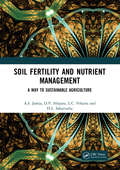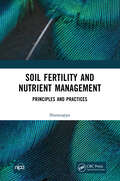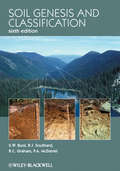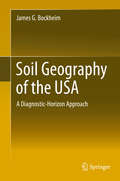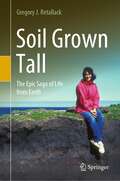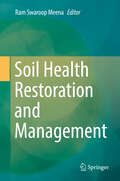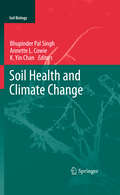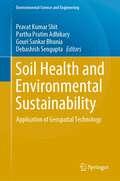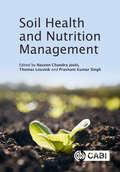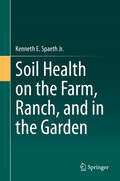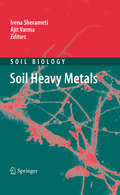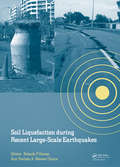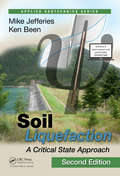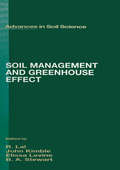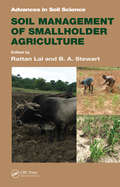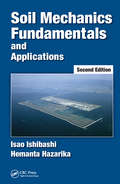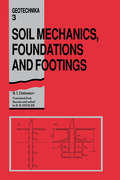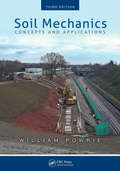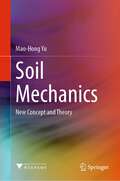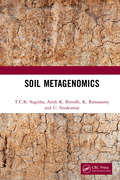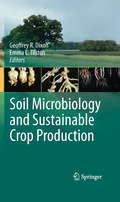- Table View
- List View
Soil Fertility and Nutrient Management: A Way to Sustainable Agriculture
by A.S. Jadeja D.V. Hirpara L.C. Vekaria H.L. SakarvadiaThe book entitled Soil Fertility and Nutrient Management is a compilation work and most of the information was farmed very critically covering all the main topics of plant nutrition. The book will be serve as useful reference to students, teachers, researchers scientists, policy makers and other interested in soil science, agronomy, crop science, environmental sciences and agriculture. Note: T&F does not sell or distribute the Hardback in India, Pakistan, Nepal, Bhutan, Bangladesh and Sri Lanka.
Soil Fertility and Nutrient Management: Principles and Practices
by SharanappaUnderstanding of the dynamics of plant nutrients in the soil provides scientific basis for efficient nutrient management. Soil organic matter not only provides the nutrients required by the crop but also improve the biological and physical properties of the soil. This book collects and discusses information on production and management of organic manures, biofertilizers, integrated nutrient management in cropping systems and nutrient management in problematic soils. Print and electronic editions not for sale in South Asia (India, Sri Lanka, Nepal, Bangladesh, Pakistan, Afghanistan and Bhutan).
Soil Genesis and Classification
by Stanley W. Buol Randal J. Southard Robert C. Graham Paul A. McDanielSoil Genesis and Classification, Sixth Edition, builds on the success of the previous editions to present an unparalleled resource on soil formation and classification. Featuring a color plate section containing multiple soil profiles, this text also includes information on new classification systems and emerging technologies and databases with updated references throughout. Covering the diverse needs of both the academic and professional communities, this classic text will be a must have reference for all those in soil science and related fields.
Soil Geography of the USA
by James G. BockheimSince 1980, our understanding of the factors and processes governing the distribution of soils on the Earth's surface has increased dramatically, as have the techniques for studying soil patterns. The approach used in this book relies on the National Resources Conservation Service databases to delineate the distribution of each of the eight diagnostic epipedons and 19 subsurface horizons, to identify the taxonomic level at which each of these horizons is used, to develop an understanding of the role of the factors and processes in their formation and to summarize our latest understanding of their genesis. A chapter is devoted to each diagnostic horizon (or combined horizons). This book is intended to serve as a textbook in soil geography, a reference book for geographers, ecologists and geologists and a tool for soil instructors, landlookers, mappers, classifiers and information technologists.
Soil Grown Tall: The Epic Saga of Life from Earth
by Gregory J. RetallackThis book is designed as an easy night's read and introduction to fossil soils and the relatively new disciplines of Paleopedology and Astropedology. It includes line art and color illustrations to visualize the topic for the informed layperson or interested colleagues. It provides comprehensive information on paleosols, which are soils of the past providing a variety of clues to the evolution of life and climate on Earth and deals with topics such as the evolution of grassland ecosystems, mass extinction of the Late Permian and origin of life, all viewed from the perspective of the fossil record of soils. This turns out to be a refreshing new perspective of wide interest.
Soil Health (Soil Biology #59)
by Ajit Varma Bhoopander GiriThis book gathers the latest insights into soil health and its sustainability, providing an up-to-date overview of the various aspects of soil quality and fertility management, e.g., plant-microbe interactions to maintain soil health; and the use of algal, fungal and bacterial fertilizers and earthworms for sustainable soil health and agricultural production.It first discusses the past, present, and future scenarios of soil health, and then explores factors influencing soil health, as well as the consequences of degradation of soil health for sustainable agriculture. Lastly it highlights solutions to improve and maintain soil health so as to achieve greater productivity and sustainability without damaging the soil system or the environment.Soil health is defined as the capacity of a soil to function within ecosystem frontiers, to sustain biological productivity, to maintain environmental quality and to promote plant, animal and human health. Soil health is established through the interactions of physical, chemical and biological properties, e.g., soil texture, soil structure, and soil organisms. Healthy soil provides adequate levels of macro- and micronutrients to plants and contains sufficient populations of soil microorganisms. As a result of the increasingly intensified agriculture over the past few decades, soils are now showing symptoms of exhaustion and stagnating or declining crop yields. Exploring these developments as well as possible solutions based on holistic and sustainable approaches, this book is a valuable resource for researchers in the area of soil and environmental science, agronomy, agriculture, as well as students in the field of botany, ecology and microbiology.
Soil Health Analysis, Set (ASA, CSSA, and SSSA Books)
by Douglas L. Karlen Diane E. Stott Maysoon M. MikhaVolume 1 briefly reviews selected &“Approaches to Soil Health Analysis&” including a brief history of the concept, challenges and opportunities, meta-data and assessment, applications to forestry and urban land reclamation, and future soil health monitoring and evaluation approaches.Volume 2 focuses on &“Laboratory Methods for Soil Health Analysis&” including an overview and suggested analytical approaches intended to provide meaningful, comparable data so that soil health can be used to guide restoration and protection of our global soil resources.
Soil Health Restoration and Management
by Ram Swaroop MeenaMeeting the food requirements of an ever-increasing population is a pressing challenge for every country around the globe. Soil degradation has a negative impact on food security by reducing the cultivated land areas, while at the same time the world population is predicted to increase to 9.2 billion in 2050. Soil degradation adversely affects soil function and productivity and degraded soils now amount to 6 billion ha worldwide. The major factors are salinization, erosion, depletion of nutrients due to exhaustive agricultural practices and contamination with toxic metal ions and agrochemicals, which reduces the activity of soil microbe. In addition, poor soil management also decreases fertility. As such, measures are required to restore the soil health and productivity: organic matter, beneficial microorganisms and nutrient dynamics can all improve the physical, chemical and biological properties of soil. Understanding the role of soil health restoration and management in sustainability and nutritional security calls for a holistic approach to assess soil functions and examine the contributions of a particular management system within a defined timescale. Further, best management practices in cropping systems are important in ensuring sustainability and food and nutritional security without compromising the soil quality and productivity potential. Rational soil management practices must allow environmentally and economically sustainable yields and restoration of soil health.
Soil Health and Climate Change
by Bhupinder Pal Singh Annette L. Cowie K. Yin Chan"Soil Health and Climate Change" presents a comprehensive overview of the concept of soil health, including the significance of key soil attributes and management of soil health in conventional and emerging land use systems in the context of climate change. Starting with a review of the physical, chemical and biological indicators of soil health and their significance for monitoring the impacts of climate change, this book then focuses on describing the role of soil structure, pH, organic matter, nitrogen, respiration and biota in sustaining the basic functions of soil ecosystems, and their anticipated responses to climate change. Further topics include the management of cropping, pastoral, and forestry systems, and rehabilitated mine sites, with a focus on mitigation of and adaptation to climate change impacts. Finally, the opportunities and potential risks of organic farming, biochar and bioenergy systems, and their ability to sustain and even enhance soil health, are discussed.
Soil Health and Environmental Sustainability: Application of Geospatial Technology (Environmental Science and Engineering)
by Debashish Sengupta Gouri Sankar Bhunia Pravat Kumar Shit Partha Pratim AdhikaryThis book demonstrates the measurement, monitoring, mapping and modelling of soil pollution and land resources. This book explores state-of-the-art techniques based on open sources software & R statistical programming and modelling in modern geo-computation techniques specifically focusing on the recent trends in data mining/machine learning techniques and robust modelling in soil resources. Soil and agricultural systems are an integral part of the global environment and human well‐being, providing multiple goods and services essential for people worldwide and crucial for sustainable development. Soil contamination is an environmental hazard and has become a big issue related to environmental health. The challenge of the twenty-first century is to reduce the contaminant load and bring it to below permissible level. The contamination is not only a problem affecting local environments at the place of occurrence but also spreading to other regions because of easy transportation of pollutants. This leads to direct and indirect contamination of land and aquatic systems, surface water and groundwater, inducing significant risks for natural ecosystems. In this context, the spatial modelling, prediction, efficient use, risk assessment, protection and management of soil resources in the agriculture system are the key to achieving sustainable development goals and ensuring the promotion of an economically, socially and environmental sustainability future. The aim of this book on soil contaminants and environmental health: application of geospatial technology is to identify the soil and sediment quality, sources of contaminants and risk assessment and focuses on the decision-making and planning point of view through GIS data management techniques. This book covers major topics such as spatial modelling in soil and sediments pollution and remediation; radioactive wastes, microbiology of soil and sediments, soil salinity and sodicity, pollution from landfill sites, soil erosion and contamination from agricultural activities, heavy metal pollution and health risk; environmental impact and risk assessment, sustainable land use, landscape management and governance, soil degradation and risk assessment, agricultural soil pollution, pollution due to urban activities, soil pollution by industrial effluents and solid wastes, pollution control and mitigation in extreme environments. The content of this book is of interest to researchers, professionals and policy-makers whose work is in soil science and agriculture practices. The book equips with the knowledge and skills to tackle a wide range of issues manifested in geographic data, including those with scientific, societal and environmental implications.
Soil Health and Nutrition Management
A major challenge for agriculture and future crop production is the deterioration in soil health and fertility. We have large areas of barren land across the globe with degraded soil which can only be made fertile by applying proper nutrition and soil health management practices. It is crucial to protect soil health in order to feed the world's ever-growing population. Healthy soil is a dynamic ecosystem containing microbes that aid in the breakdown of organic materials and minerals, increasing the availability of plant nutrients (nutrient recycling) and enhancing soil quality and crop output. Healthy soil also helps mitigate the impact of climate change by maintaining nutrients and sequestering atmospheric carbon. This book summarizes the numerous components of soil health management including cutting-edge technologies such as genome editing and rhizospheric engineering, together with conventional techniques for preserving soil nutrients.
Soil Health on the Farm, Ranch, and in the Garden
by Kenneth E. Spaeth Jr.This book explores the importance of soil health in croplands, rangelands, pasturelands, and gardens, and presents new methods and technologies for assessing soil dynamics and health in these different land types. Through perspectives of agriculture, soil management, and ecological sustainability, the book provides accurate and up-to-date information on soil health assessment and maintenance that is often missing from current literature on conservation and environmental management and preservation. The book is written in a clear and concise format, and will appeal to non-scientists interested in soil health, as well as professional farmers, ranchers and gardeners. The book begins by discussing soil health from a historical perspective, and in terms of how it is covered in the news currently. Then the author addresses the ecological implications of soil health in farming, ranching and gardening, and comprehensively details the physical, chemical and biological properties of soil as they apply in various land types. The book then examines soil health assessment using new diagnostic and analytic technologies, and how these new innovations will be necessary going forward to maintain and improve soil health.
Soil Heavy Metals
by Ajit Varma Irena SherametiHuman activities have dramatically changed the composition and organisation of soils. Industrial and urban wastes, agricultural application and also mining activities resulted in an increased concentration of heavy metals in soils. How plants and soil microorganisms cope with this situation and the sophisticated techniques developed for survival in contaminated soils is discussed in this volume. The topics presented include: the general role of heavy metals in biological soil systems; the relation of inorganic and organic pollutions; heavy metal, salt tolerance and combined effects with salinity; effects on abuscular mycorrhizal and on saprophytic soil fungi; heavy metal resistance by streptomycetes; trace element determination of environmental samples; the use of microbiological communities as indicators; phytostabilization of lead polluted sites by native plants; effects of soil earthworms on removal of heavy metals and the remediation of heavy metal contaminated tropical land.
Soil Liquefaction during Recent Large-Scale Earthquakes
by Nawawi Chouw Rolando P. Orense Ikuo TowhataSoil Liquefaction during Recent Large-Scale Earthquakes contains selected papers presented at the New Zealand � Japan Workshop on Soil Liquefaction during Recent Large-Scale Earthquakes (Auckland, New Zealand, 2-3 December 2013). The 2010-2011 Canterbury earthquakes in New Zealand and the 2011 off the Pacific Coast of Tohoku Earthquake in
Soil Liquefaction: A Critical State Approach, Second Edition (Applied Geotechnics)
by Mike Jefferies Ken BeenA Rigorous and Definitive Guide to Soil LiquefactionSoil liquefaction occurs when soil loses much of its strength or stiffness for a time-usually a few minutes or less-and which may then cause structural failure, financial loss, and even death. It can occur during earthquakes, from static loading, or even from traffic-induced vibration. It occurs w
Soil Management and Greenhouse Effect (Advances in Soil Science #6)
by B.A. Stewart John M. Kimble Elissa R. LevineSoil Management and Greenhouse Effect focuses on proper management of soils and its effects on global change, specifically, the greenhouse effect. It contains up-to-date information on a broad range of important soil management topics, emphasizing the critical role of soil for carbon storage. Sequestration and emission of carbon and other gases are examined in various ecosystems, in both natural and managed environments, to provide a comprehensive overview. This useful reference includes chapters that address policy issues, as well as research and development priorities. The material in this volume is valuable not only to soil scientists but to the entire environmental science community.
Soil Management of Smallholder Agriculture (Advances in Soil Science)
by Rattan Lal B. A. StewartNearly two billion people depend on hundreds of millions of smallholder farmers for food security. Yet, these farmers' lives also hang in the balance due to their extreme vulnerability to the risks of soil degradation and depletion, soil exhaustion, climate change, and numerous biotic and abiotic stresses. Soil Management of Smallholder Agriculture
Soil Management: Problems and Solutions
by Michael A Fullen John A CattThe soil is a fundamental constituent of the Earth's system, maintaining a careful state of equilibrium within the biosphere. However, this natural balance is being increasingly disturbed by a variety of anthropogenic and natural processes, leading to the degradation of many soil environments. Soil Management provides a comprehensive and authoritative introduction to the many problems, challenges and potential solutions facing soil management in the twenty-first century. Covering a range of topics, including erosion, desertification, salinization, soil structure, carbon sequestration, acidification and chemical pollution, the book also develops a prognosis for the future of soil management in the face of growing populations and global warming.Written with the needs of students in mind, each chapter provides a broad overview of a problem, analyses approaches to its solution and concludes with references and suggestions for further reading. Soil Management will be of great value to environmental science and geography undergraduates taking soil management courses in their second or third year.
Soil Mechanics Fundamentals and Applications
by Isao Ishibashi Hemanta HazarikaHow Does Soil Behave and Why Does It Behave That Way?Soil Mechanics Fundamentals and Applications, Second Edition effectively explores the nature of soil, explains the principles of soil mechanics, and examines soil as an engineering material. This latest edition includes all the fundamental concepts of soil mechanics, as well as an introduction to
Soil Mechanics Through Project-Based Learning
by Dong-Sheng Jeng Ivan Gratchev Erwin OhThe currently available soil mechanics textbooks explain theory and show some practical applications through solving abstract geotechnical problems. Unfortunately, they do not engage students in the learning process as students do not "experience" what they study. This book employs a more engaging project-based approach to learning, which partially simulates what practitioners do in real life. It focuses on practical aspects of soil mechanics and makes the subject "come alive" through introducing real world geotechnical problems that the reader will be required to solve. This book appeals to the new generations of students who would like to have a better idea of what to expect in their employment future. This book covers all significant topics in soil mechanics and slope stability analysis. Each section is followed by several review questions that will reinforce the reader’s knowledge and make the learning process more engaging. A few typical problems are also discussed at the end of chapters to help the reader develop problem-solving skills. Once the reader has sufficient knowledge of soil properties and mechanics, they will be offered to undertake a project-based assignment to scaffold their learning. The assignment consists of real field and laboratory data including boreholes and test results so that the reader can experience what geotechnical engineering practice is like, identify with it personally, and integrate it into their own knowledge base. In addition, some problems include open-ended questions, which will encourage the reader to exercise their judgement and develop practical skills. To foster the learning process, solutions to all questions are provided to ensure timely feedback.
Soil Mechanics, Footings and Foundations: Geotechnika - Selected Translations of Russian Geotechnical Literature 3
by B.I. DalmatovTranslated from the second Russian edition of 1988. Parts 2, "Soil mechanics" and 3, "Foundations and footings" are revised and updated versions of the first Russian edition of 1981. Part 1, "Special course in engineering geology," contains a discussion of physicomechanical properties of soil, geody
Soil Mechanics: Concepts and Applications, Third Edition
by William PowrieInstead of fixating on formulae, Soil Mechanics: Concepts and Applications, Third Edition focuses on the fundamentals. This book describes the mechanical behaviour of soils as it relates to the practice of geotechnical engineering. It covers both principles and design, avoids complex mathematics whenever possible, and uses simple methods and ideas to build a framework to support and accommodate more complex problems and analysis. The third edition includes new material on site investigation, stress-dilatancy, cyclic loading, non-linear soil behaviour, unsaturated soils, pile stabilization of slopes, soil/wall stiffness and shallow foundations. Other key features of the Third Edition:• Makes extensive reference to real case studies to illustrate the concepts described• Focuses on modern soil mechanics principles, informed by relevant research• Presents more than 60 worked examples • Provides learning objectives, key points, and self-assessment and learning questions for each chapter• Includes an accompanying solutions manual for lecturersThis book serves as a resource for undergraduates in civil engineering and as a reference for practising geotechnical engineers.
Soil Mechanics: New Concept and Theory
by Mao-Hong YuThis book focuses on the unified solutions and analysis for the problems in soil mechanics based on the unified strength theory, which is a new theory on the yield and failure of materials under multi-axial stresses. Then, it provides a system of yield and failure criteria adopted for most materials, from metallic materials to rocks, concretes, soils, polymers, etc. It includes the Tresca criterion, Mohr–Coulomb theory, and Mises criterion as well, which are special cases or linear approximation of the UST.
Soil Metagenomics
by T.C.K. Sugitha Asish K. Binodh K. Ramasamy U. SivakumarThis book focuses on the recent advents and technological breakthroughs in metagenomic approaches coupled with their applications in agriculture. The intended audience include soil and environmental microbiologists, molecular biologists and policy makers. The book expertly describes the latest fourth generation metagenomic technologies from sample collection to data analysis, metatranscriptomic, metaproteomic and metabolomics studies Note: T& F does not sell or distribute the Hardback in India, Pakistan, Nepal, Bhutan, Bangladesh and Sri Lanka.
Soil Microbiology and Sustainable Crop Production
by Geoffrey R. Dixon Emma L. TilstonSoils into which crop plants root and from which they obtain essential minerals and water contain huge arrays of microbes. Many have highly beneficial effects on crop growth and productivity, others are pathogens causing diseases and losses to yield and quality, a few microbes offer protection from these pathogenic forms and others have little or no effect. These intimate and often complex inter-relationships are being explored with increasing success providing exciting opportunities for increasing crop yields and quality in sustainable harmony with the populations of beneficial soil microbes and to the detriment of pathogens. This book explores current knowledge for each of these aspects of soil microbiology and indicates where future progress is most likely to aid in increasing crop productivity by means which are environmentally benign and beneficial.
